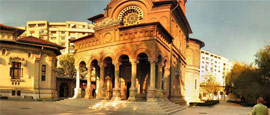Travel to Bucharest
Flying to Bucharest
Airlines offering direct flights from the UK to Bucharest include Blue Air, British Airways, Ryanair, TAROM and Wizz Air. Fares usually rise during peak summer months, so you're likely to find the best deals in the off-season, by flying midweek, or by booking well ahead.
From London - 3 hours 10 minutes; New York - 11 hours 30 minutes (including stopover); Los Angeles - 14 hours 15 minutes (including stopover); Toronto - 11 hours 30 minutes (including stopover); Sydney - 25 hours (including stopovers).
Website:www.bucharestairports.ro
Location:
The airport is located 16.5km (10.5 miles) northwest of central Bucharest.
Money:
Bureaux de change offices are located in Arrivals and Departures. There are numerous ATMs in Arrivals, and one in Departures. There are two full-service bank branches.
Luggage:
Baggage trolleys are provided free of charge, but there is no left luggage or porter service. A wrapping service is available. Lost and found desks are located in the baggage claim area.
Travel by road
Roads in Romania are generally poor with numerous potholes, horse carts and speed traps. Drum National (DN) roads are the main roads and European (E) routes, while Drum Judetean (DJ) are county routes. Speed limits are 130kph (81mph) on motorways (autostrada), 90-100kph (55-62mph) on other non-urban roads and 50kph (31mph) within built-up areas. The motorway along the Black Sea coast charges a toll. The minimum driving age is 18 years.
EU visitors only need a national photo driving licence, but you may need an International Driving Permit if visiting from outside the EU, particularly if your licence isn't in English; check with your car hire company. Green Card insurance documents are helpful, but not compulsory for EU visitors.
The Romanian Automobile Club - ACR (tel: +40 21 222 2222; www.acr.ro) has reciprocal agreements with a number of foreign automobile associations and members are automatically covered in the event of breakdown.
ACR (tel: 9271, in Romania only).
Bucharest is connected to the rest of the country by four motorways - the E70 from Pitesti, the E60 from Brasov via Ploiesti, the E85 from Giurgiu on the Bulgarian border and the E60 from Constanta on the Black Sea coast.
From Cluj-Napoca - 6 hours; Belgrade - 8 hours; Budapest - 10 hours; Sofia - 5 hours 30 minutes.
Coaches travel to both Romanian and international cities but most are reached more quickly and comfortably by rail. Eurolines, Buzesti 44 (tel: +40 21 316 7782; www.eurolines.ro), connects Bucharest with cities across Europe. Coaches leave from a few locations, including this one. You can buy tickets from the driver but it's advisable to purchase your tickets in advance, particularly for international destinations.
Travel by rail
Gara de Nord, Bulevardul Garii de Nord 2, is the city's main railway station. There are daily direct trains from/to Budapest, Sofia and Vienna.
Those entering the station without a train ticket are charged a small fee at the station entrance; this is to discourage pickpockets and other petty criminals. The ticket counter for domestic trains is on the station's right-hand side; international trains are to the left.
Bucharest also has two smaller railway stations (Gara Obor, Bulevardul Garii 3, and Gara Baneasa, Strada Dr Minovici 1) serving trains running east to the coast, during the summer.
The Romanian state railway, CFR (tel: +40 21 9521; www.cfrcalatori.ro), provides a reliable and often scenic means of transport to destinations outside Bucharest. You can buy advance tickets for all trains at the CFR offices on Strada Domnita Anastasia 10-14. Visitors departing within 24 hours, however, must buy their tickets at the relevant railway station, where queues can be long. Prices are reasonable and first-class tickets are recommended, as the extra comfort is worth the cost. Tickets are checked at the platform entrance.
There are four types of train. InterCity trains (indicated by IC on timetables) are fastest and only stop at major Romanian cities, such as Cluj-Napoca, Iasi and Timisoara. The next fastest are rapid trains (indicated in green), then accelerat (red). The slowest are the local trains (personal).
From Budapest - 15 hours 40 minutes; Sofia - 9 hours 30 minutes; Vienna - 19 hours.
Do you have any Feedback about this page?
© 2026 Columbus Travel Media Ltd. All rights reserved. No part of this site may be reproduced without our written permission, click here for information on Columbus Content Solutions.








 You know where
You know where